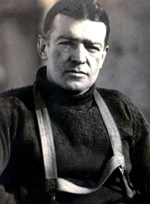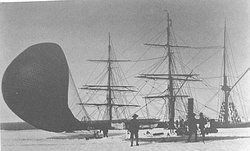Ernest Shackleton
|
|
Discoveryboat.jpg
Nimrod1.jpg
Sir Ernest Henry Shackleton (February 15, 1874 – January 5, 1922) was an Irish-born British explorer, now chiefly remembered for his Antarctic expedition of 1914–1916 in the ship Endurance.
| Contents |
Biography
Shackleton was born in Kilkea, Ireland in 1874, and served as a merchant marine officer. He went to school at Dulwich College from 1887 to 1890. In 1904 he married Emily Dorman.
Antarctic Expeditions
1901 National Antarctic Expedition
Shackleton participated in the National Antarctic Expedition, which was organized by the Royal Geographical Society in 1901, and led by Robert Falcon Scott. This expedition is also called the "Discovery Expedition," as its ship was called the RRS Discovery. The expedition was the first to penetrate the Ross Sea and reach the Ross Ice Shelf. He may have placed what has become one of the world's most famous advertisements in the Times of London in December 1901: "Men wanted for hazardous journey. Small wages. Bitter cold. Long months of complete darkness. Constant danger. Safe return doubtful. Honour and recognition in case of success." (Some historians have claimed that this ad was placed, although they do not all agree on when or which newspaper, but no one has yet been able to locate the original newspaper clipping; see [1] (http://www.antarctic-circle.org/advert.htm) for a full discussion.)
1902
Shackleton with Scott and Dr. Edward Wilson trekked south towards the South Pole in 1902. The journey proceeded under difficult conditions, partially the result of their own inexperience with the Antarctic environment, poor choices and preparation and the pervading assumption that all obstacles could be overcome with personal fortitude. They used dogs, but failed to understand how to handle them. As with most of the early British expeditions, food was foolishly in short supply; the personnel on long treks were usually underfed by any sensible measure and were essentially starving. Scott, Wilson and Shackleton made their "furthest south" of 82?17'S on December 31, 1902. They were 480 statute miles from the Pole. Shackleton developed scurvy on the return trip and Dr. Wilson suffered from snow blindness at intervals.
When the Morning relieved the expedition in early 1903, Scott had Shackleton returned to England, though he had nearly fully recovered. There is some suggestion that Scott disliked Shackleton's popularity in the expedition and used his health as an excuse to remove him; he was Merchant Marine and Scott was Royal Navy—which was also part of the contention with whether Armitage was to remain for the second winter. In part, Scott exhibited unusual stamina and may not have recognized differing abilities of others.
1907–1909 British Antarctic Expedition
Shackleton organized and led the "British Antarctic Expedition" (1907–1909) to Antarctica. The primary and stated goal was to reach the South Pole. The expedition is also called the Nimrod Expedition after its ship, and the "Farthest South" expedition. Shackleton's base camp was built on Ross Island at Cape Royds, approximately 20 miles (40 km) north of the Scott's Hut of the 1901–1904 expedition. Because of poor success with dogs during Scott's 1901–1904 expedition, Shackleton used Manchurian ponies for transport, which did not prove successful.
Accomplishments of the expedition included the first ascent of Mount Erebus, the active volcano of Ross Island; the location of the Magnetic South Pole by Douglas Mawson, David and MacKay (January 16, 1909); and locating the Beardmore Glacier passage. Shackleton, with Wild, Marshall, and Adams, reached 88?23'S: a point only 180 km (97 nautical miles) from the South Pole.
Shackleton returned to the United Kingdom a hero and was immediately knighted. For three years he was able to bask in the glory of being "the man who reached furthest to the south." Of his failure to reach the South Pole, Shackleton remarked: "Better a live donkey than a dead lion."
1914–1916 Imperial Trans-Antarctic Expedition
Drift_of_the_Endurance.png
The Imperial Trans-Antarctic Expedition set out in 1914. Its goal was to cross the Antarctic from a location near Vahsel Bay on the south side of the Weddell Sea, reach the South Pole and then continue to Ross Island on the opposite side of the continent. The expedition's goal had to be abandoned when the ship, Endurance, was beset by sea ice short of its goal of Vahsel Bay. It was later crushed by the pack ice. The ship's crew and the expedition personnel endured an epic journey by sledge across the Weddell Sea pack and then boat to Elephant Island. Upon arrival at Elephant Island off the Antarctic Peninsula, they rebuilt one of their small boats and Shackleton with five others set sail for South Georgia to seek help. This remarkable journey in a 6.7 meter boat (the James Caird) through the Drake Passage to South Georgia in the late Antarctic Fall (April and May) is perhaps without rival. They landed on the southern coast of South Georgia and then crossed the spine of the island in an equally remarkable 36-hour journey. The 22 men who remained on Elephant Island were rescued by the Chilean ship Yelcho after three other failed attempts on August 30, 1916 (22 months after departing from South Georgia). Everyone from Endurance survived.
Many details of the expedition were recorded on movie camera and in photography. Expedition journals were carefully kept and are preserved to this day.
Meanwhile, a supply mission had been sent to the other side of the continent to lay food depots for Shackleton's group. Their ship was lost in a storm, stranding the company, but they set out across the Ross Ice Shelf to lay the supplies regardless. In December 1916, Shackleton embarked on a rescue mission to pick up members of this group, the Ross Sea Party. Although they suffered casualties, this party still managed to lay food depots.
The Endurance
Endurance was the three-masted barquentine in which Shackleton sailed for the Antarctic on the Imperial Trans-Antarctic Expedition in 1914. Built in Norway by the Framnaes shipyard she was launched on December 17, 1912 and was initially called Polaris. She was 144 feet (43.9 m)long, 25 feet (7.6 m) in beam and weighed 350 tons (356 metric tons). As well as sails she had a 350 hp (260 kW) steam engine driving a single shaft, giving a top speed of around 10 knots (19 km/h). She was designed for polar conditions with a very sturdy construction, including twice as many frames as normal.
She was built for Adrien de Gerlache and Lars Christensen. They intended to use her for polar cruises for tourists. Financial problems meant that Christensen was happy to sell the boat to Shackleton for ?11,600, less than cost. She was renamed Endurance after the Shackleton family motto "fortitudine vincimus".
She was trapped in the Antarctic ice for 281 days, before the pressure of the ice crushed and sank her on November 21, 1915.
The Endurance is considered the last ship of her kind.
1921 Final expedition
Autumn-sunset.web.jpg
In 1921, Shackleton set out on another Antarctic expedition, but died of a heart attack on board his ship, the Quest, while anchored off South Georgia Island on January 5, 1922. His body was being returned to England when his widow requested that the burial take place on Grytviken, South Georgia Island instead. Shackleton was buried there on March 5.
Legacy
In 1994, the James Caird Society was set up to preserve the memory of Shackleton's achievements. Its first Life President was Shackleton's younger son, Edward Shackleton.
Sir Ernest Shackleton is the subject of Shackleton, a two-part Channel 4 drama directed by Charles Sturridge and starring Kenneth Branagh as the explorer. The same story is related in greater detail in the book Endurance: Shackleton's Incredible Voyage, by Alfred Lansing.
Shackleton's grave, near the former whaling station at Grytviken on South Georgia is frequently visited by tourists from passing cruise ships.
The British Antarctic Survey's logistics vessel RSS Ernest Shackleton (the replacement for RRS Bransfield) is named in his honour.


